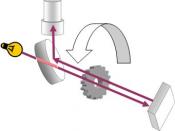The speed of light in a vacuum is exactly 299,792,458 m/s. In 1983 physicists agreed to define a metre using the speed of light, i.e. a metre is defined as the distance traveled by a ray of light in a vacuum in 1/299,792,458s. The speed of light reduces when it passes through matter. It is hardly slowed down by air, but the speed of light through glass is reduced to around 200 000 km/s. Less dense materials (like water or ice) reduce the speed of light significantly, but not as much as glass.
"Aristotle, believed the speed of light was infinite, so the event and the observation of the event would be simultaneous. Galileo suggested a method for measuring the speed of light:
1. Jack and Jill, stand a good distance (d) apart. Both are carrying shuttered lamps.
2. Jill removes the shutter from her lamp.
3. Jack, seeing Jill's lamp removes the shutter from his lamp.
4. Jill sees Jack's lamp. She records the time difference between unmasking her lamp and seeing Jack's lamp.
5. Jill calculates the velocity of light c = 2d/t"
The Speed of Light is Constant
In contrast to normal intuition, the Theory of Relativity tells us that light always travels at the same speed relative to some observer, no matter what the relative motion of the observer. So, "light emitted from a moving airplane does not travel with the speed of light plus the speed of the airplane, it travels with the "speed of light", no matter what the speed of the airplane! In a vacuum, light always travels at a speed of 299,792,458 meters per second, no matter how its speed is measured."


